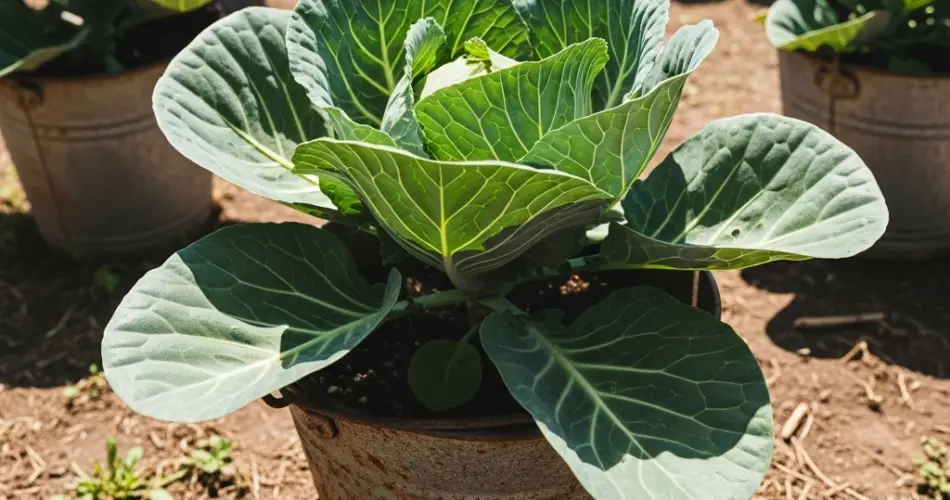Cabbage is a nutritious and versatile vegetable, rich in vitamins, minerals, and antioxidants. It is widely used in salads, soups, stews, and fermented dishes like sauerkraut. For gardeners with limited space, growing cabbage in buckets provides an efficient and practical way to enjoy fresh produce year-round. Container gardening allows for better control of soil, drainage, and sunlight, ensuring healthy plants and a productive harvest. This guide offers detailed instructions for growing cabbage successfully in buckets.
Why Container Gardening Works for Cabbage
Cabbage is well-suited to container gardening because it can thrive in nutrient-rich, well-draining soil and requires moderate space for its root system. Using buckets allows gardeners to manage soil composition, moisture, and temperature, which is essential for producing firm, healthy heads. Bucket gardening is especially beneficial for urban environments, balconies, patios, or small yards, where traditional garden space is limited. Containers also make harvesting easier and reduce exposure to pests and soil-borne diseases.
Choosing the Right Cabbage Variety
Selecting the appropriate cabbage variety is key for container gardening. Choose compact or “dwarf” varieties that form smaller, tighter heads, making them ideal for buckets. Popular varieties for container growth include “Miniature Ball,” “Golden Acre,” and “Early Jersey Wakefield.” These types produce firm heads, mature relatively quickly, and are suitable for year-round planting. Selecting the right variety ensures that the cabbage fits well within a bucket while delivering high-quality produce.
Selecting and Preparing Buckets
Choose buckets that are at least 12–14 inches deep and wide enough to accommodate a single cabbage plant comfortably. Larger buckets can support multiple plants if spaced properly. Ensure each container has adequate drainage holes to prevent waterlogging, which can lead to root rot. For better drainage, add a thin layer of gravel or small stones at the bottom before filling the bucket with soil. Clean the containers thoroughly to reduce the risk of disease and pests.
Soil Preparation
Cabbage thrives in fertile, well-draining soil with a slightly acidic to neutral pH of 6.0–7.0. Fill your buckets with high-quality potting mix blended with compost or well-rotted organic matter to improve fertility and moisture retention. Adding perlite or coarse sand enhances drainage and prevents soil compaction, which is vital for root development. Avoid using heavy garden soil, which can restrict growth and lead to poorly formed heads.
Planting Cabbage in Buckets
Cabbage can be grown from seeds or transplants. If starting from seeds, sow them indoors 6–8 weeks before the last expected frost, then transplant seedlings into buckets once they reach 4–6 inches tall. For direct planting, place seedlings or small transplants into the bucket soil at the same depth they were growing in their nursery pots. Space plants at least 12–18 inches apart to allow enough room for head development. Water thoroughly after planting to settle the soil and encourage root establishment.
Sunlight Requirements
Cabbage grows best in full sun, ideally receiving six or more hours of direct sunlight daily. Place your buckets in a sunny location, such as a balcony, terrace, or patio. Adequate sunlight promotes strong leaves, firm heads, and healthy overall growth. In warmer climates, light afternoon shade can protect the leaves from scorching while still allowing sufficient light for optimal development.
Watering and Care
Consistent moisture is crucial for container-grown cabbage. Water regularly to keep the soil evenly moist, avoiding overwatering, which can cause root rot. Mulching with straw or shredded leaves helps retain moisture, regulate soil temperature, and reduce weed growth. Remove yellowing or damaged leaves to maintain plant health and airflow. Regular inspection for pests such as aphids or cabbage worms will help prevent damage to your plants.
Fertilization
Cabbage is a heavy feeder and benefits from regular fertilization. Use a balanced, slow-release fertilizer or organic compost tea every two to three weeks to support leaf and head development. Proper feeding ensures firm, compact heads and vibrant foliage. Avoid over-fertilizing with high nitrogen products, as this can promote excessive leaf growth at the expense of head formation.
Harvesting Cabbage
Cabbage heads are typically ready to harvest 70–100 days after transplanting, depending on the variety. Harvest when the heads feel firm and compact by cutting them at the base with a sharp knife. Remove outer leaves if damaged or yellowed to maintain overall plant health. For successive harvesting, plant new cabbage seedlings in staggered intervals, providing a continuous supply of fresh heads throughout the year.
Advantages of Bucket Cabbage Gardening
Growing cabbage in buckets maximizes limited space, allows for precise soil and water management, and reduces pest and disease problems. Containers are portable, enabling gardeners to move plants for optimal sunlight or protection from extreme weather. Additionally, bucket-grown cabbage is easier to harvest, cleaner, and often healthier than those grown in traditional garden beds.
Conclusion
Bucket gardening makes growing cabbage accessible and practical for urban gardeners and small-space enthusiasts. By choosing the right variety, preparing nutrient-rich soil, providing adequate sunlight, and maintaining consistent watering and fertilization, you can enjoy firm, healthy cabbage heads year-round. Container-grown cabbage offers the satisfaction of homegrown vegetables, providing fresh, nutritious produce straight from your balcony, patio, or small garden space.



